The Apple iPad Review (2012)
by Vivek Gowri & Anand Lal Shimpi on March 28, 2012 3:14 PM ESTThe Display: In Numbers
Apple is very big on maintaining a consistent experience between its products. We see this a lot in our Mac reviews where it's not unusual to see similar white points across virtually all Apple products. It's no surprise that the with the move to the Retina Display Apple wanted to retain as much of the original iPad's display characteristics as possible. We'll start with an analysis of brightness and contrast, both of which remain relatively unchanged from the iPad 2:
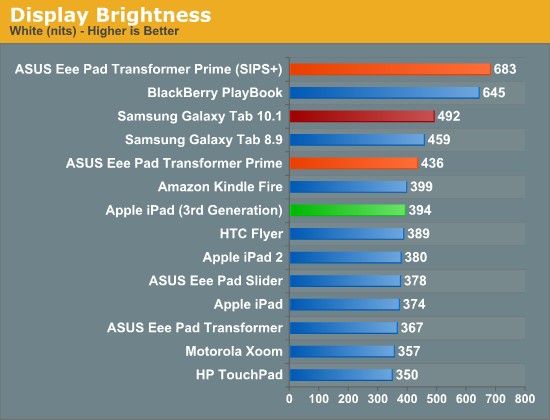
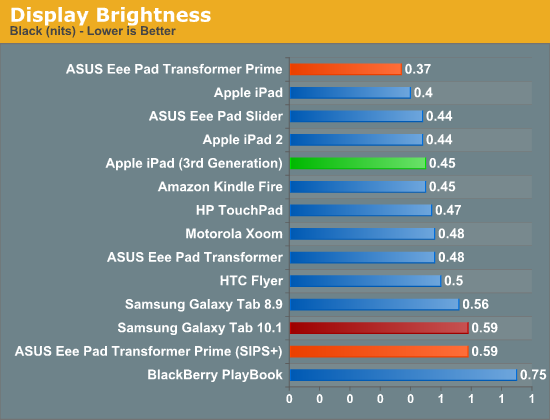
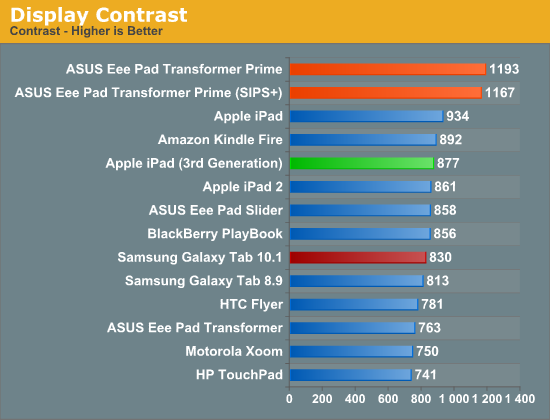
Apple is expected to have triple sourced panels for the new iPad, so you can expect to see variation in these results but for the most part you can expect the new iPad's display to perform similarly to the previous model.
Despite similar brightness and contrast to the previous model, the new iPad offers remarkably better color gamut and color reproduction than its predecessor. Relative to other tablets, the iPad's display is spectacular.
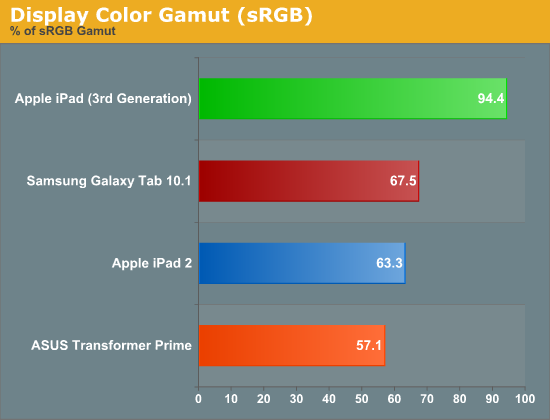
As we mentioned in our Retina Display analysis, Apple delivered on its claims of a 44% increase in color gamut. The new iPad offers nearly full coverage of the sRGB color space and over 60% of the Adobe RGB gamut:
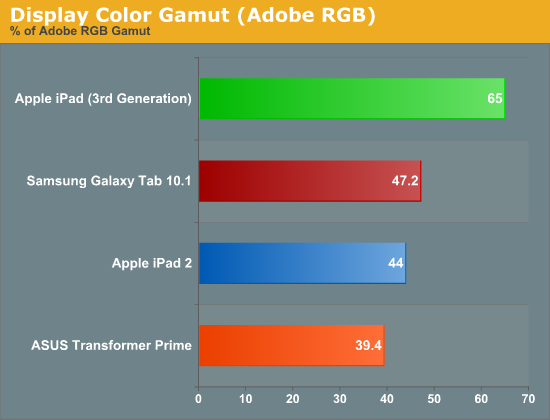
Below is the CIE diagram for the new panel with an sRGB reference plotted on the same chart so you can visualize the data another way:
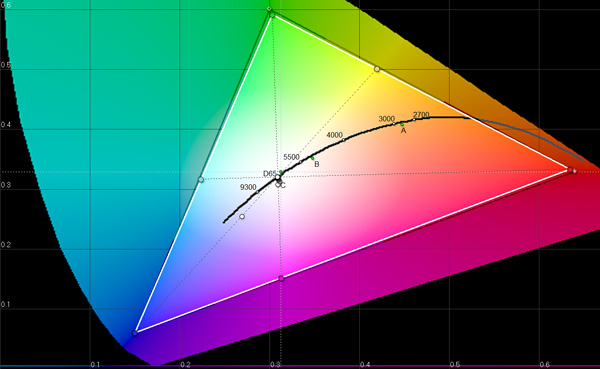
Color accuracy has improved tremendously if we look at delta E values for the primary and secondary colors:
Remember from our display reviews, lower delta E values indicate greater color accuracy. Values below 4 are typically considered good and you can see that the iPad 2 as well as the Transformer Prime both fell short in this department. With the new iPad Apple has clearly focused on color accuracy, which makes sense given it was used as the vehicle to introduce iPhoto for iOS.
Apple still has a lot of work ahead of itself to really put forth a professional quality display in a tablet, but for now the Retina Display is easily the best we've seen in a tablet and a tremendous step forward.
What's most absurd about the iPad's Retina Display is that you're able to get this resolution and panel quality in a $499 device. While we must be careful not to give Apple too much credit here as Samsung, Sharp and its other display partners clearly make the Retina Display, it's obvious that Apple has really been pushing its partners to develop solutions like this.
The biggest problem in the production of any commoditized component is the primary motivation for innovation is to lower cost. For years I argued with notebook PC makers to use higher quality LCD panels but no one was willing to commit to the quantities that would lower costs enough. I was also told that as soon as you put these notebooks on shelves at Best Buy, users wouldn't really care whether they were getting a high quality IPS display or not—all that mattered was the final price.
Apple, under the leadership of Steve Jobs, had a different mentality. Steve's pursuit was quality and experience, cost was a secondary concern. Through slow and steady iteration of this approach, Apple was able to build up a large enough customer base and revenue to be a significant force in the industry when it came to driving costs down. Apple can easily fill your fabs and eat all that you can produce, but you'll have to do whatever it wants to get the order.
Apple's behavior since it got rich has been to drive down the cost of higher quality components, LCDs being a perfect example. Unfortunately other companies don't benefit as much here as Apple tends to buy up all of the production of what it has pushed to create. That's one reason why, although ASUS was first to introduce a 1080p Transformer Pad, it won't launch until well after the new iPad. From what I've heard, the panel makers are all busy servicing Apple's needs—everyone else comes second.
Eventually the entire industry will benefit and all indications point to Apple doing something special for "pro" users in the notebook space next. As I've said previously, Apple has raised the bar with the iPad's Retina Display. The time for average display quality in a $500 tablet is over, the bar has been raised. It remains to be seen whether or not Apple will be able to maintain this quality across all suppliers of its Retina Display. On the iPhone Apple has been entirely too lax about maintaining consistency between suppliers. If it wants to be taken seriously in this space Apple needs to ensure a consistent experience across all of its component vendors.

















234 Comments
View All Comments
vol7ron - Thursday, March 29, 2012 - link
Think you meant "except" :)adityarjun - Friday, March 30, 2012 - link
No, you aren'tsiddharth7 - Friday, March 30, 2012 - link
Yeah! Kind of a typo :). Also forgot the question mark. :-)Wanted to edit it, but was not able to after posting. :)
Xyraxx - Thursday, March 29, 2012 - link
Ok, gaming clearly the TF came out ahead. Why the backhanded commentary in that section? I don't see that for the sections that the iPad clearly won. TF takes the overall top spot for its gaming performance. But instead of commentary on that, we get aggressive talk about how they should be pushing even further ahead, and how they are failing at it.The controller compatibility is an absolute win for the Android side, but instead of talk about that, we get this "Yeah, but who says controllers will win over touch". Its like every advantage the iPad doesn't win over, gets trotted out and downplayed as if to say it doesn't mean anything, or somehow doesn't matter.
darkcrayon - Thursday, March 29, 2012 - link
Interesting. I got a different impression entirely. It seems like games specifically optimized for the Tegra 3 by nVidia were somewhat better visuallyr, but the iPad has a more extensive game library and considering the GPU is far more powerful than the Tegra 3's, it's only a matter of time before there are far better graphics to be had on iPad games.Though there is no OS level controller support in iOS, both Bluetooth and dock connector controllers are possible (hence the iControlpad iCade, and a few others). It may be that more games support them now on Android, but nothing is stopping developers from supporting them on iOS at this point.
Finally, it's pretty important that ~100% of the iPad games in the App Store will run on the new iPad, which can't be said for the TF as shown in the review, or probably for any other individual Android tablet.
mr_ripley - Thursday, March 29, 2012 - link
It seems to me that the iPad does charge when I plug it into the USB port on my Macbook Pro. In fact I was surprised to see that not only did it not say "not charging" and show the "plugged-in" icon, it also seemed pretty fast (I will have to try it again to see if it was as fast as the power charger).However, when I tried to this morning to plug it into my Lenovo laptop it showed "not charging". Does this only work when plugged into Apple products?
vol7ron - Thursday, March 29, 2012 - link
This question seems better suited for the Apple support forums.doobydoo - Sunday, April 1, 2012 - link
This reply seems better suited to the kids-r-us forum.Aenean144 - Thursday, March 29, 2012 - link
Modern Macs have special USB hubs that output 7 to 8 Watts of power (~5V at ~1.6A). Most Windows machines or non-Macs and older Macs output about 4.5 Watts max. There's a USB battery charging specification, but I'm not aware of any computers that have this implemented.So, most Mac should be able to charge an iPod, iPad, iPhone relatively quickly. A PC with the normal USB specs will typically do it a little bit slower. 40 to 50%. 4.5 Watts is basically the bare minimum. Doable on an iPad 2 with the screen off, but the 2012 iPad will be tough. If you have the screen off, turn off WiFi and Bluetooth, it'll charge ok if Apple lets it. The screen has to be off with 4 Watt power source.
mr_ripley - Thursday, March 29, 2012 - link
Ah ha! Thanks for the clarification. When I saw that I was able to charge my new ipad while using it with my Macbook pro USB, I neglected to bring along my charger to work. Seems like that was unwise.But I still have around 50% power left so should be fine for today. And yes I do use it at work.